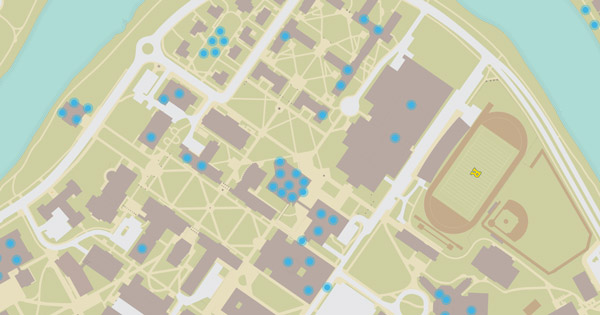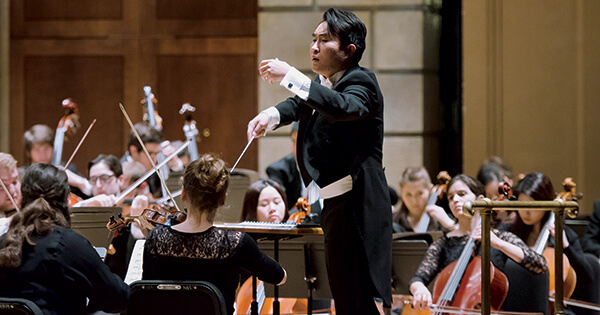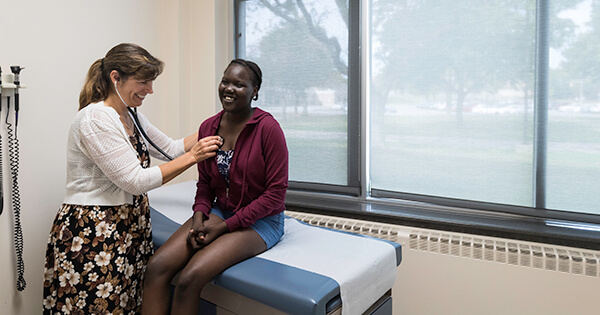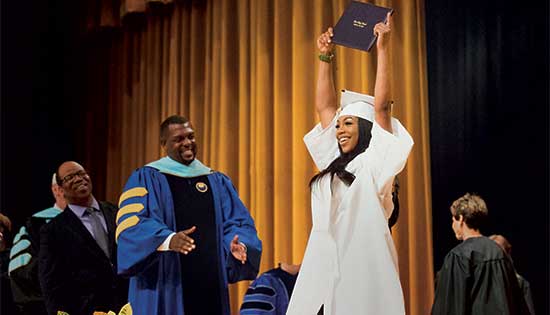UR Medicine leads in surgery for LVAD heart pump
Cardiac surgeons used two 3-inch incisions to place a HeartMate 3 LVAD, extending the life of a Southern Tier man with congestive heart failure.
UR Medicine cardiac surgeons recently introduced a minimally invasive approach to implanting the newest heart pump available for people with congestive heart failure. This is believed to be the first in the nation, and potentially a game-changer for patients.
The HeartMate 3™ LVAD is the next-generation left ventricular assist device for advanced congestive heart failure. The device supplements the pumping action of a weakened heart. It is approved for use as a bridge-to-transplant, which means the pump will support their heart function for patients waiting for a heart transplant. UR Medicine’s Strong Memorial Hospital is Upstate New York’s only center approved to use LVADs, because of the strength of its comprehensive heart failure and transplantation program.
“This is a significant advance for patients who can receive this life-saving device without weeks or months of recovery,” said heart transplant surgeon Igor Gosev, M.D. He worked closely with cardiac surgeon Peter Knight, M.D., and anesthesiologist Laurent Glance, M.D., to carefully place the one-pound device near the base of the heart of a Southern Tier man.
Surgeons have traditionally implanted heart pumps through a large opening in the sternum (the breast bone), similar to open heart surgery. It is a successful technique, though recovery can be long and there is risk of infection and scar-tissue growth.

Igor Gosev, M.D.
“It has been our goal to use a minimally invasive approach with the LVAD because this new device is smaller and the placement on the heart is optimal,” Knight said. He leads the Minimally Invasive Cardiac Surgery Program and has advanced techniques over the last two decades, nationally recognized for his innovation and leadership in the field.
On Feb. 12, surgeons made two 3-inch incisions–one under the heart and another below the collar bone on the right side – to implant the pump. Some surgeons in Europe have used a similar technique. The device, made by Abbott, was approved by the FDA in August and UR Medicine heart surgeons began planning to perform the alternate method.

Peter Knight, M.D.
“This is a great example of teamwork and dedication to providing the best care for our patients,” said Cardiac Surgery Chief Sunil Prasad, M.D. “In this procedure, Dr. Knight, who has performed hundreds of minimally invasive heart surgeries, and Dr. Gosev, who has implanted hundreds of LVADs, came together to use this minimally invasive approach and our patients have done extremely well.”
The Heart and Vascular team has been implanting LVADs for nearly 20 years, having participated in early clinical studies that led to their standard use for heart failure. To date, the team has provided LVADs to more than 500 people, some of whom have traveled from Northern New York, Albany, Buffalo and the Southern Tier and Pennsylvania for care.
Using minimally invasive techniques, patients often experience less pain and blood loss, lower risk of complications, shorter hospital stay, improved quality of life and heart function. Especially important for heart failure patients is the ability to return home, with their loved ones, as they await heart transplantation. Some people face months of hospitalization waiting for a matching donor heart.

Loren Vinal of Corning
The team, which includes cardiac surgeon Bryan Barrus, M.D., has performed the surgery for five people in the past three weeks.
‘I couldn’t breathe’
Corning guitarist Loren Vinal first recognized signs of heart trouble last summer, when climbing stairs and walking was difficult. Physicians initially treated him for a virus and then a lung disorder, because heart failure is rarely considered the cause of breathing difficulties for someone his age.
His symptoms worsened during a trip to Nashville for a performance and vacation.
“I didn’t feel right and I couldn’t breathe,” Vinal said. Doctors at Vanderbilt University Medical Center diagnosed cardiomyopathy, a weakened heart and elevated risk of sudden cardiac death. While hospitalized there, Vinal suffered a heart attack – another indication that his heart was deteriorating.
Vanderbilt doctors fitted him with a Lifevest, an external defibrillator, which tracked his heart rhythm and delivered a therapeutic shock to restore a safe and steady heartbeat. They encouraged him to seek care at Strong Memorial, upstate’s only comprehensive heart failure and transplantation service, when he returned home.
“After 13 days in the hospital, I finally flew back to Corning. But just a day later, I couldn’t breathe again,” Vinal said.
Cardiologists John Rich, M.D., and Ravi S. Akula, M.D., of Arnot Ogden Medical Center in Elmira, quickly transferred him to Strong, the region’s leader in heart care, according to U.S. News and World Report 2017-18 Best Hospitals. Strong cardiologists work close with Arnot Ogden physicians to provide complex heart care.
Leway Chen, M.D., M.P.H., medical director of the Advance Heart Failure Program, said medications and close monitoring by the heart failure team weren’t effective for Vinal. “He needed a new heart and we placed him on the waiting list. Initially we thought he could withstand the wait for a new heart, but we detected changes in his heart and had to shift our plans and put in the heart pump.”
Vinal was frightened by the rapid decline of his heart health the week before receiving the HeartMate 3 LVAD.
“At first the doctors thought my heart could last six months and then it was a month, and then a week. On a Friday the doctors said they were worried I wouldn’t make it through the weekend,” the Syracuse native recalled. “That was hard to take, but I have to say the whole team did everything they could to make me comfortable.”
Jeffrey Alexis, M.D., medical director of the VAD and artificial heart program, said that scenario is common for patients in heart failure. The transition from the use of effective medications to needing a heart pump can be quick.
“The benefit for Mr. Vinal is that minimally invasive surgery wasn’t as much trauma to his body as the open approach. We know that the sicker you are going into this surgery, the sicker you are coming out,” Alexis said. “Once the LVAD is in place, people start to feel better, because their blood flow improves and they start having more energy through the long recovery. And now that we are able to place the pump without opening their chest, it’s a real plus for our patients.”
Vinal recovered quickly, leaving the cardiac intensive care unit just two days after surgery, and went home two weeks later. Most patients who receive an LVAD are hospitalized three weeks or more after surgery.
About congestive heart failure and LVADs
More than 5.7 million people in the U.S. suffer from heart failure and approximately 915,000 new patients are diagnosed each year. For congestive heart failure patients who can no longer rely on earlier stage treatment options, an LVAD can help their weakened heart pump blood through the body and provide crucial support as patients await further treatment, including heart transplants.
“Heart failure is a crippling and costly disease and why it’s important to be able to offer these patients a technology that gives them the opportunity to return to a better quality of life,” said Alexis.
Congestive heart failure treatment options are limited: LVAD and/or heart transplantation. LVADs extend survival and can be used as the destination therapy or a bridge-to-transplant, as the HeartMate 3 is used. Unfortunately only 1 in 10 people waiting for a new heart receive one because of the shortage of donors. In New York, organ donation is low and Upstate New York patients have longer wait times than many areas of the country.
Strong Memorial is one of the highest volume LVAD centers in the nation and UR Medicine cardiac surgeons and cardiologists participate in clinical studies of the newest devices, providing patients access to next-generation technology before other sites in the nation.
The collaborative nature of the Heart and Vascular program led to this advance, which is expected to be studied by peers at other academic medical centers, Prasad said.
—URMC PR, March 2018






